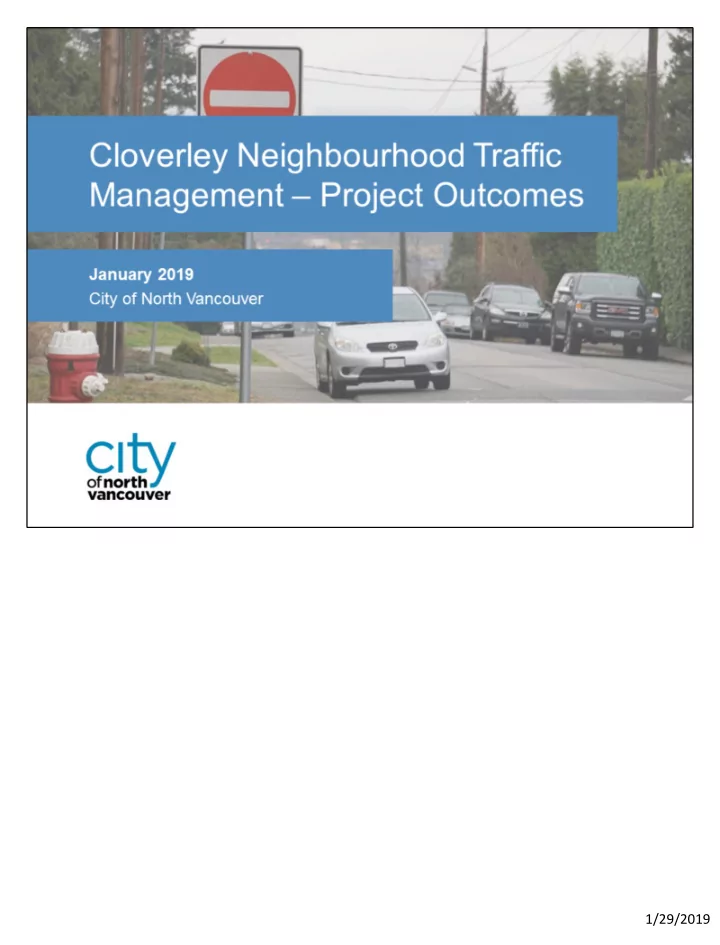

1/29/2019
1/29/2019
1/29/2019
Traffic management requires a careful balance between access and restriction; more restrictions for drivers impacts both residents and shortcutters. This is why it is necessary to create a clear objective before a plan is developed, to capture this balance as agreed upon by the neighbourhood residents. The objective outline at the start of the Cloverley process clearly captures the community’s interest in maintaining access for local residents, while also discouraging shortcutters. 1/29/2019
This image outlines the access management process followed, beginning with plan development in 2016 through to today. Steps included public engagement and feedback, implementation of access management measures in two phases, and data collection and reporting on the impact of the measures. Following the community meetings this January and February, there will be an input period opportunity, as it is important for us to hear back from the community. 1/29/2019
Phase 1 Plan implemented Summer 2017 1/29/2019
Final Phase Plan implemented Summer 2018 1/29/2019
As the process was developed and throughout the phased implementation, we have received a lot of feedback from the community that was very valuable. Over the past number of years we’ve met with and spoken with a lot of people. This slide does not highlight all of the comments, but here are a few key pieces of feedback we’ve received. 1/29/2019
The above slide identifies the locations where volume and speed data was collected throughout the process. 1/29/2019
The next four slides highlight specific traffic volume trends, specifically eastbound traffic on weekday afternoons on the 700 and 800 blocks of 4 th , 5 th , 6 th , and 7 th . Volumes have been expressed in vehicles per hour (vph) . For the presentation, we have focused on these blocks as a clear way of showing the trends before and after the implementation of traffic management measures, recognizing that the issues continue further east in the Cloverley neighbourhood. Key Terms: • Typical Day: average weekday volume (3-6pm) on non-incident days. • Incident Days: days where collisions on surrounding road network result in significant congestion on neighbourhood streets. Incident day volume reported as the maximum observed hourly volume. Slide 10 represents vehicles per hour for a typical commute before access management measures were introduced. Observations: 1. Hourly volumes are very low when compared to other neighbourhoods in Metro Vancouver. This is because the community has two parallel arterials with lots of capacity. 4 th carries more volume for local eastbound traffic for people making their way into the 2. neighbouring streets as they come off of 3 rd . 1/29/2019
Represents vehicles per hour for a typical commute after measures were introduced (2018). Observations: 1. Hourly volumes are still very low when compared to other neighbourhoods in Metro Vancouver. This is because the community has two parallel arterials with lots of capacity. 2. Local traffic has primarily rerouted in response to the one-way restrictions, except for some drivers who disobey the one-way restrictions on 4 th Street. 1/29/2019
Represents vehicles per hour for an incident day commute before access management measures were introduced. Observations: Shortcutting vehicles predominantly use 4 th Street and Heywood Street to queue jump onto Keith 1. Road. 1/29/2019
Represents vehicles per hour for an incident day commute after measures were introduced. Observations: Redistribution of shortcutting traffic from 700 and 800 Blocks 4 th Street to other blocks 1. 2. Some traffic disobeying one-way restrictions 3. Use of laneways as shortcutting routes 1/29/2019
Summary of eastbound hourly volumes on the 700 blocks E 4 th , 5 th , 6 th , and 7 th . 1/29/2019
Aggregating the data from the previous slide (700 blocks of E 4 th , 5 th , 6 th , and 7 th ) allows us to easily make the following observations: 1. Eastbound volume entering the neighbourhood from Queensbury has reduced on typical days. This is likely explained by residents and visitors being impacted by the measures and taking different routes to get to their homes. 2. Eastbound volume entering the neighbourhood has not significantly decreased with the installation of traffic restrictions. 1/29/2019
Slide 16 shows the observed 85 th percentile PM Peak vehicle speeds from the most recent Fall 2018 data collection. Posted speed limits on streets is 50 km/hr, except blocks adjacent to Cloverley School and Park which are 30km/h during posted hours. Key Terms: 85 th percentile speed: the speed at or below which 85 percent of all vehicles are observed to travel. • 1/29/2019
1/29/2019
Community input will be solicited through a survey which will be mailed out, by late February, to each household within the project area (Cloverley Community – East of Queensbury). Survey questions will gather preferences on themes noted above. Following the survey, Staff will submit a report to Council summarizing the process, data , input from the community and provide a recommendation. 1/29/2019
Mailout survey will be sent to every household east of Queensbury in late February. Residents will be able to complete the survey online, or return the paper copy to City Hall by mail or in person. West of Queensbury traffic management process is set to begin in Fall 2019, following Council input on the Cloverley process. 1/29/2019
1/29/2019
Recommend
More recommend